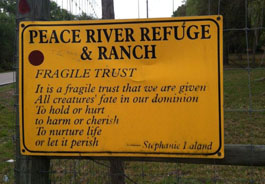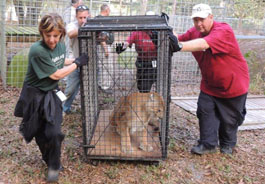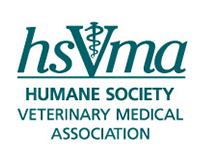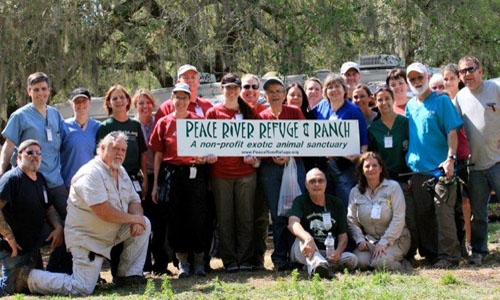Caravan of Careby Barry Kellogg, VMD April 8, 2013 The veterinary profession isn't just a job, it's a vocation, a calling. Consequently, many of our members spend their time off in interesting ways that often involve them applying their training and skills. This month, HSVMA member and senior veterinary medical advisor Barry Kellogg, VMD, recounts the not-so-typical extended weekend he recently enjoyed.  Dr. Kellogg and a team of nearly 50 volunteers helped move the animals of Forest Animal Rescue by Peace River Refuge & Ranch to a new property in February. Barry Kellogg, VMD/HSVMA In addition to my work with HSVMA and Humane Society International, I serve as the veterinary advisor to the board of directors of Forest Animal Rescue by Peace River Refuge & Ranch, a lifetime care sanctuary in Florida for non-releasable wild animals. The animals there have been rescued by my friends Kurt and Lisa Stoner from lives of abuse or neglect and the likelihood of being destroyed for lack of a place to go. The animals in their care range from tigers and cougars to bears, wolves, primates, bats and more. Due to encroaching residential development and sale of the original site, the animal care permit to their original property in Zolfo Springs was in jeopardy, forcing them to purchase and relocate to a new 80 acre property. This new acreage is almost completely surrounded by the Ocala National Forest in Silver Springs, and therefore won't be threatened by future development. I have a long history as a disaster responder, and the logistical challenge of safely moving 138 animals 140 miles presented a great opportunity to stage a training exercise in animal evacuation. Florida is hurricane country, and the possibility of damage to the many animal sanctuaries, zoos, and theme parks that contain animals is a very real danger that those facilities face each year from June to October. The Stoners coordinated the recruitment of a team of 48 volunteers from all over the country. They were all highly-trained animal disaster responders from seven different emergency response groups, including members of the Florida State Animal Response Coalition and RedRover.  Dr. Kellogg and veterinary technician Kelly Colardici observe Roy the tiger before he is moved to a trailer. Betsy Kellogg Early on in the planning, I knew I wanted to recruit fellow HSVMA member, veterinary technician Kelly Coladarci, to help with the veterinary medical aspects of the move. I have worked with Kelly both in response and training venues domestically and abroad, and knew she would be a great asset. Despite the many hurdles we faced, our team's detailed and extensive planning and preparation enabled us to accomplish the move without any animal (or human) mishaps or injuries. Safety of all creatures "great and small," was a main priority. This was another fine example of how well an Incident Command System can be utilized to assemble, supervise, and effectively carry out an incident response. For four straight days starting at 7 a.m., our team had to either lure the animals into their travel-safe trailers or resort to darting and anesthesia. Some of the bigger animals, such as the tigers, the leopard, and one of the bears, had to be anesthetized completely and then carried on stretchers to waiting transport cages before loading. Smaller animals like bats, including the large bats known as flying foxes, were caught by hand, and all animals that were due were also vaccinated before transporting them to their new home. By mid-day, the caravan of two transport trailers and anywhere from five to nine cars was able to get on the road, traveling north on Interstate 75 in a single-file on a four hour drive.  Volunteers transport a cougar to a trailer. Beth Gammie/RedRover The trailers each held a different group of animals separated in compartments. Predators and prey animals had to be carried in separate loads to help minimize their stress. The bigger, more dangerous animals were anesthetized with a dart gun or a pole syringe for safety reasons, but some animals stayed awake for the length of the journey. The trailers were air-conditioned and equipped with infrared video-monitoring systems that allowed the crew to keep watch over their charges. For safety reasons, the team tried to stay as inconspicuous as possible when they had to make rest stops. But a caravan of exotic animals is difficult to keep "hidden," especially when I was going from trailer to trailer with a stethoscope trying to check all the animals' vital signs before heading back down the road. Between 4 and 6 p.m. each day – sometimes in the dark – we arrived at the new sanctuary adjoining the Ocala National Forest and unloaded the animals into their temporary lockout pens, where they will remain until their larger enclosures (some as large as an acre) are finished. Then we'd turn right back around and make another four hour drive back to Zolfo Springs to get a few hours sleep and then repeat the process the next day. All told, we made four round trips. If you are interested in learning more about – or even volunteering for – or donating to Forest Animal Rescue as it's now known, please visit the group's website, peaceriverrefuge.org.
While your leisure time activities or volunteer efforts may not have been as exotic as Barry and Kelly's, we know that our members are doing worthy and interesting things in their communities and we want to share your stories. Please contact us at [email protected] if you would like to have your tale told through publication on hsvma.org. We'd love to hear from you!  Barry Kellogg, VMD Dr. Barry Kellogg is HSVMA's Senior Veterinary Advisor. He has more than 30 years of experience in private practice, as well as extensive experience in disaster response. In addition to playing a key role in the development of the VMAT program, he served on the Veterinary Program Leadership Committee for the VMAT program and was its Chairman for 4 years. He has also served as the interim Assistant Director for Disaster Preparedness for the American Veterinary Medical Association, and was a member of and served as the Chair of the Committee on Disaster and Emergency Issues for the AVMA. Read his full bio» |

